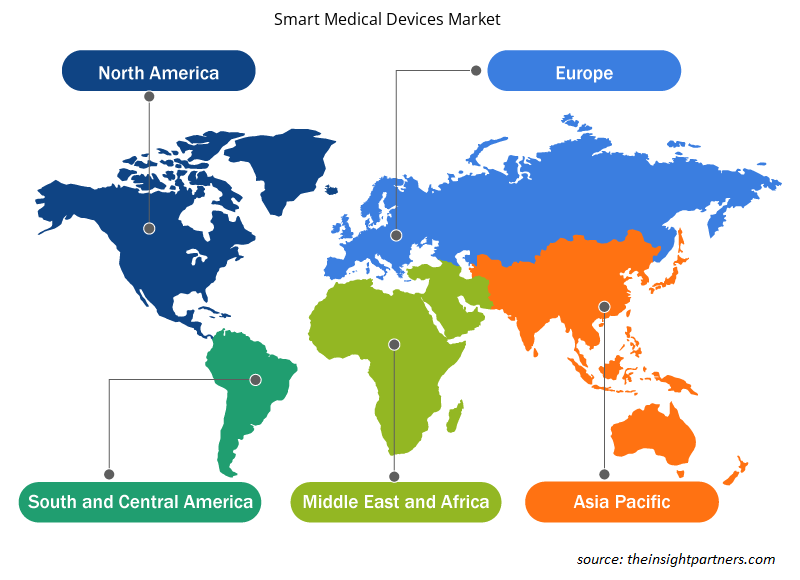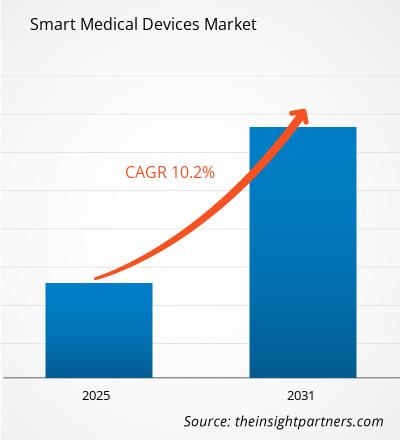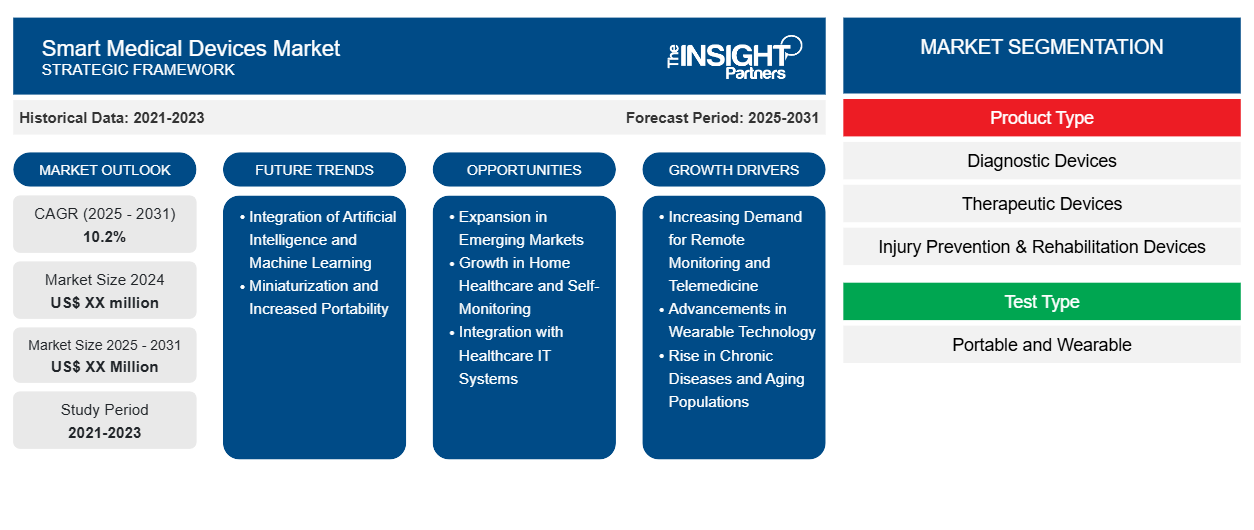Si prevede che il mercato dei dispositivi medici intelligenti registrerà un CAGR del 10,2% dal 2024 al 2031, con una dimensione di mercato in espansione da XX milioni di dollari nel 2024 a XX milioni di dollari entro il 2031.CAGR of 10.2% from 2024 to 2031, with a market size expanding from US$ XX million in 2024 to US$ XX Million by 2031.
Il report è suddiviso in base a Tipo di prodotto (Dispositivi diagnostici, Dispositivi terapeutici, Dispositivi per la prevenzione e la riabilitazione degli infortuni e Altri), Tipo di test (Portatile e indossabile), Utente finale (Ospedali e cliniche, Ambienti di assistenza domiciliare e Altri). Il report offre il valore in USD per l'analisi e i segmenti di cui sopra.
Scopo del rapporto
Il report Smart Medical Devices Market di The Insight Partners mira a descrivere il panorama attuale e la crescita futura, i principali fattori trainanti, le sfide e le opportunità. Ciò fornirà spunti a vari stakeholder aziendali, come:
- Fornitori/produttori di tecnologia: per comprendere le dinamiche di mercato in evoluzione e conoscere le potenziali opportunità di crescita, consentendo loro di prendere decisioni strategiche informate.
- Investitori: condurre un'analisi completa delle tendenze in merito al tasso di crescita del mercato, alle proiezioni finanziarie del mercato e alle opportunità esistenti lungo la catena del valore.
- Enti di regolamentazione: regolamentano le politiche e le attività di controllo sul mercato allo scopo di ridurre al minimo gli abusi, preservare la fiducia degli investitori e sostenere l'integrità e la stabilità del mercato.
Segmentazione del mercato dei dispositivi medici intelligenti
Tipo di prodotto
- Dispositivi diagnostici
- Dispositivi terapeutici
- Dispositivi per la prevenzione e la riabilitazione degli infortuni
- Altri
Tipo di prova
- Portatile e indossabile
Utente finale
- Ospedali e cliniche
- Impostazioni di assistenza domiciliare
- Altri
Geografia
- America del Nord
- Europa
- Asia-Pacifico
- America del Sud e Centro
- Medio Oriente e Africa
Personalizza questo report in base alle tue esigenze
Riceverai la personalizzazione gratuita di qualsiasi report, comprese parti di questo report, o analisi a livello nazionale, pacchetto dati Excel, oltre a usufruire di grandi offerte e sconti per start-up e università
-
Scopri le principali tendenze di mercato in questo rapporto.Questo campione GRATUITO includerà analisi di dati che spaziano dalle tendenze di mercato alle stime e alle previsioni.
Driver di crescita del mercato dei dispositivi medici intelligenti
- Domanda crescente di monitoraggio remoto e telemedicina: il mercato dei dispositivi medici intelligenti si sta espandendo a causa della domanda crescente di servizi di monitoraggio remoto dei pazienti e di telemedicina. Man mano che i sistemi sanitari continuano a evolversi sempre di più verso il modello di assistenza domiciliare, la necessità di apparecchiature diagnostiche in tempo reale diventa inevitabile. Tali dispositivi consentono ai pazienti con malattie croniche di ricontrollare facilmente il sistema sanitario, migliorando la comodità, i servizi che i pazienti ricevono e anche il mercato.
- Progressi nella tecnologia indossabile: l'uso di dispositivi indossabili per la salute come i tracker sanitari, gli smartwatch e i monitor ECG ha cambiato significativamente il settore sanitario. Tali dispositivi facilitano il monitoraggio costante dei segni vitali e dei parametri sanitari come la frequenza cardiaca, la pressione sanguigna e i livelli di glucosio, consentendo ai pazienti di gestire efficacemente la propria salute. L'aumento della disponibilità degli utenti a indossare tali dispositivi per scopi sanitari sta inoltre guidando la crescita del mercato in qualsiasi contesto clinico e anche nei mercati di consumo.
- Aumento delle malattie croniche e invecchiamento della popolazione: i fattori di rischio della gestione delle malattie croniche come diabete, malattie cardiovascolari, malattie respiratorie e altre condizioni croniche, insieme alla popolazione anziana, stanno generando la domanda di dispositivi medici intelligenti. Questi dispositivi consentono la gestione e il monitoraggio delle condizioni croniche per ridurre l'incidenza dei ricoveri ospedalieri per tali pazienti e migliorare la loro qualità di vita. La geografia demografica della popolazione anziana stimola ancora di più la medicina personalizzata ed efficace.
Tendenze future del mercato dei dispositivi medici intelligenti
- Integrazione di intelligenza artificiale e apprendimento automatico: il mercato dei dispositivi medici intelligenti sta venendo rimodellato dalla tecnologia dell'intelligenza artificiale e dal suo cugino ML. Gli algoritmi di intelligenza artificiale consentono non solo di migliorare la diagnosi e l'accuratezza della prescrizione, ma anche di prevedere quanto sia aggressiva una malattia o quale tipo di terapia debba essere offerta a determinati pazienti. Consentono ai dispositivi di raccogliere, archiviare e analizzare i dati di un paziente nello stesso momento, mentre distanziano il tempo per il miglioramento delle opzioni di trattamento e forniscono suggerimenti per migliorare l'erogazione dell'assistenza sanitaria e la sua disponibilità e intelligenza per un singolo paziente, aumentando così il mercato. Il mercato dei dispositivi medici intelligenti sta venendo rimodellato dalla tecnologia dell'intelligenza artificiale e dal suo cugino ML. Gli algoritmi di intelligenza artificiale consentono non solo di migliorare la diagnosi e l'accuratezza della prescrizione, ma anche di prevedere quanto sia aggressiva una malattia o quale tipo di terapia debba essere offerta a determinati pazienti. Consentono ai dispositivi di raccogliere, archiviare e analizzare i dati di un paziente nello stesso momento, mentre distanziano il tempo per il miglioramento delle opzioni di trattamento e forniscono suggerimenti per migliorare l'erogazione dell'assistenza sanitaria e la sua disponibilità e intelligenza per un singolo paziente, aumentando così il mercato.
- Miniaturizzazione e maggiore portabilità: la miniaturizzazione dei dispositivi medici è una delle tendenze significative osservate oggi nel mercato dei dispositivi medici intelligenti. Tali dispositivi, relativamente più piccoli e leggeri, aiutano i pazienti a migliorare l'aderenza al trattamento e a migliorare il comfort del paziente. I dispositivi, che possono essere molto piccoli come gli ECG portatili o le pompe per insulina, stanno rendendo i servizi sanitari molto più accessibili ai pazienti, in particolare a coloro che necessitano di cure costanti o che necessitano del servizio mentre si spostano.
Opportunità di mercato per i dispositivi medici intelligenti
- Espansione nei mercati emergenti: nuove aree geografiche, in particolare nelle regioni Asia-Pacifico e America Latina, offrono un potenziale enorme per i dispositivi medici intelligenti. Queste regioni stanno diventando più urbanizzate, i sistemi sanitari stanno migliorando e c'è una maggiore consapevolezza sulla salute, tutti fattori che aumentano la necessità di dispositivi medici. Dispositivi intelligenti semplici e convenienti che soddisfano le attuali esigenze di assistenza sanitaria, probabilmente aumenteranno i tassi di adozione di dispositivi medici intelligenti in quelle aree.
- Crescita dell'assistenza sanitaria domiciliare e dell'automonitoraggio: l'assistenza sanitaria domiciliare e l'automonitoraggio sono tendenze in crescita che andranno a beneficio significativo del mercato dei dispositivi medici intelligenti. I cardiofrequenzimetri indossabili, i dispositivi di monitoraggio del glucosio e gli stetoscopi digitali consentono ai pazienti di prendersi cura di sé stessi quando preferiscono. Con l'aumento della domanda di gestione della salute a distanza, la gamma di dispositivi intelligenti pensati solo per uso domestico è in aumento.
- Integrazione con i sistemi IT sanitari: un'opportunità nasce dalla fusione di apparecchiature cliniche e risorse di sistemi informatici delle strutture sanitarie come le cartelle cliniche elettroniche (HER) e le loro controparti cloud. Questi sistemi supportano l'integrazione dei dati consentendo la condivisione dei dati, il monitoraggio dei pazienti esternamente e gli aggiornamenti dello stato di salute in tempo reale, il che migliora la diagnosi e il trattamento dei pazienti. Ciò promuove lo scopo dei dispositivi intelligenti avanzati nell'erogazione dei servizi sanitari e aumenta la loro domanda sul mercato.
Approfondimenti regionali sul mercato dei dispositivi medici intelligenti
Le tendenze regionali e i fattori che influenzano il mercato dei dispositivi medici intelligenti durante il periodo di previsione sono stati ampiamente spiegati dagli analisti di Insight Partners. Questa sezione discute anche i segmenti e la geografia del mercato dei dispositivi medici intelligenti in Nord America, Europa, Asia Pacifico, Medio Oriente e Africa e America meridionale e centrale.

- Ottieni i dati specifici regionali per il mercato dei dispositivi medici intelligenti
Ambito del rapporto di mercato sui dispositivi medici intelligenti
| Attributo del report | Dettagli |
|---|---|
| Dimensioni del mercato nel 2024 | XX milioni di dollari USA |
| Dimensioni del mercato entro il 2031 | XX milioni di dollari USA |
| CAGR globale (2025 - 2031) | 10,2% |
| Dati storici | 2021-2023 |
| Periodo di previsione | 2025-2031 |
| Segmenti coperti |
Per tipo di prodotto
|
| Regioni e Paesi coperti |
America del Nord
|
| Leader di mercato e profili aziendali chiave |
|
Densità degli attori del mercato dei dispositivi medici intelligenti: comprendere il suo impatto sulle dinamiche aziendali
Il mercato dei dispositivi medici intelligenti sta crescendo rapidamente, spinto dalla crescente domanda degli utenti finali dovuta a fattori quali l'evoluzione delle preferenze dei consumatori, i progressi tecnologici e una maggiore consapevolezza dei benefici del prodotto. Con l'aumento della domanda, le aziende stanno ampliando le loro offerte, innovando per soddisfare le esigenze dei consumatori e capitalizzando sulle tendenze emergenti, il che alimenta ulteriormente la crescita del mercato.
La densità degli operatori di mercato si riferisce alla distribuzione di aziende o società che operano in un particolare mercato o settore. Indica quanti concorrenti (operatori di mercato) sono presenti in un dato spazio di mercato in relazione alle sue dimensioni o al valore di mercato totale.
Le principali aziende che operano nel mercato dei dispositivi medici intelligenti sono:
- Laboratori Abbott
- Apple, Inc.
- Società
- Fitbit, Inc.
- Società anonima F. Hoffman-La-Roche Ltd.
Disclaimer : le aziende elencate sopra non sono classificate secondo un ordine particolare.

- Ottieni una panoramica dei principali attori del mercato dei dispositivi medici intelligenti
Punti chiave di vendita
- Copertura completa: il rapporto copre in modo completo l'analisi di prodotti, servizi, tipologie e utenti finali del mercato dei dispositivi medici intelligenti, fornendo una panoramica olistica.
- Analisi degli esperti: il rapporto è compilato sulla base della conoscenza approfondita di esperti e analisti del settore.
- Informazioni aggiornate: il rapporto garantisce la pertinenza aziendale grazie alla copertura di informazioni recenti e tendenze nei dati.
- Opzioni di personalizzazione: questo report può essere personalizzato per soddisfare le esigenze specifiche del cliente e adattarsi in modo appropriato alle strategie aziendali.
Il rapporto di ricerca sul mercato dei dispositivi medici intelligenti può, quindi, aiutare a guidare il percorso di decodifica e comprensione dello scenario del settore e delle prospettive di crescita. Sebbene possano esserci alcune preoccupazioni valide, i vantaggi complessivi di questo rapporto tendono a superare gli svantaggi.
- Analisi storica (2 anni), anno base, previsione (7 anni) con CAGR
- Analisi PEST e SWOT
- Valore/volume delle dimensioni del mercato - Globale, Regionale, Nazionale
- Industria e panorama competitivo
- Set di dati Excel
Report recenti
Rapporti correlati
Testimonianze
Motivo dell'acquisto
- Processo decisionale informato
- Comprensione delle dinamiche di mercato
- Analisi competitiva
- Analisi dei clienti
- Previsioni di mercato
- Mitigazione del rischio
- Pianificazione strategica
- Giustificazione degli investimenti
- Identificazione dei mercati emergenti
- Miglioramento delle strategie di marketing
- Aumento dell'efficienza operativa
- Allineamento alle tendenze normative























 Ottieni un campione gratuito per - Mercato dei dispositivi medici intelligenti
Ottieni un campione gratuito per - Mercato dei dispositivi medici intelligenti